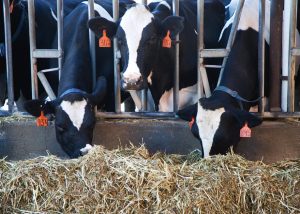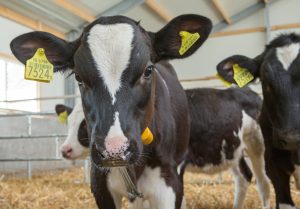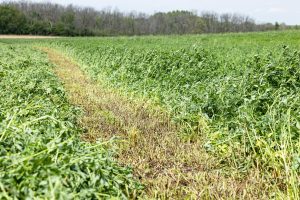Alvaro Garcia
Once the presence and concentration of mycotoxins have been determined, different practical approaches can be used to reduce their toxicity. The most common ones include: mold inhibitors (precautionary and before mold develops), fermentation enhancers (for high moisture, fermented feeds), physical separation (discard grain fines), adsorbent agents (at feeding time), blending down with clean feedstuffs to get below problem level, and strategically feeding to certain production phases.
Mold inhibitors and fermentation enhancers
Mold inhibitors (e.g., propionic acid) and fermentation enhancers (e.g., bacterial inoculants) are effective and recommended at storage time. However, there is no point in adding these agents once grain or corn silage has been stored for some time and molds and mycotoxins have already developed.
Hoffman and Combs (2009) suggest adding 5- 10 kg of actual propionic acid per ton of high-moisture corn (25% moisture or higher). Producers must keep in mind, though, that organic acid-treated grains can only be fed to livestock, and that treated grains cannot be marketed at the local elevator.
Also, mold inhibitors will do nothing against mycotoxins already present at the time of application. It is crucial to avoid unnecessary exposure of grain and silage to air during storage and feed-out and best not to feed grains that show mold growth or have a musty smell. If there is no choice other than to feed the affected grain, it is important to dilute the affected grain with safer grain sources.
Obviously, the easiest way to avoid mycotoxin problems is first not to have moldy feeds. If despite best management efforts, one still ends up with mold and toxins there are some approaches to reduce the risk of exposure.
Physical processes
Physical processes such as cleaning, sorting, and dehulling are useful in separating the most dangerous material before thinking of any inactivating agents. Since most molds thrive in dead parts and fines, cleaning and sorting is the first defense against these contaminants.
Cleaning machines such as air separators, sieving machines, and sorting by density are obvious alternatives. The concern of feed mills are losses of feeding material that can represent around 8% or more. Granted, the negative impact of the mycotoxins on animal performance can far outweigh these losses.
Dehulling has a significant impact in reducing mycotoxin contamination. This however adds a degree of complexity and may slow-down the throughput of the feed mill. Again, this is a “balancing act” between the efficiency of the plant and the negative impact on the livestock it is charged with feeding.
Blending down with clean feedstuffs
If the mycotoxin-contaminated feedstuff is diluted with a “clean” batch, it reduces the toxin concentration. The US Food and Drug Administration (FDA) and the European Union however consider unlawful the deliberate mixing of adulterated food with good food for commercial purposes regardless of the contamination level.
The Centers for Veterinary Medicine may permit blending under special provisions (requested by the states), such as when facing feed shortages resulting from a drought. Permission is granted to the petition state, and the state’s regulatory agents oversee these activities.
Discarding the fines in dry grain stored in bins is a very important practice to reduce mycotoxins concentration. Research performed at the Virginia Polytechnic Institute suggests that mechanical screening of corn can reduce aflatoxin concentration in contaminated corn.
In this trial samples from a bin were collected with a probe at depths of 1, 3, and 5 meters. The samples were mechanically shaken to separate fines from intact kernels. The aflatoxin concentration in the whole kernel fractions was 86–89% lower than that present in the fines.
Total aflatoxin concentration and concentration in the fines was higher in samples collected at 1 meter than the samples taken at the other two depths. The difference in aflatoxin concentration at different locations within a bin underscores the importance of getting representative samples when assessing mycotoxin concentrations.
Using anticaking agents (“binders”)
The FDA does not recognize the use of mycotoxin binding agents as safe. Furthermore, these products must be subjected to an approved food additive petition if they are intended (sold) to be used for this purpose. Clay-type products are generally recognized as safe (GRAS) when used in animal feeds at levels not to exceed 2%.
The concern of the FDA is that binding may not be uniform across different products, rendering them unsafe for consumption. An additional concern is that there is no certainty about what may happen to this binding once exposed to the acid environment in the stomach. If under these circumstances un-binding were to happen, the animal may excrete unsafe levels of mycotoxins in meat or milk products.
In 2009 however, the European Commission extended their definition of feed additives to include: “materials that suppress or reduce the absorption of mycotoxins, promote the excretion of mycotoxins or modify their mode of action and thereby mitigate possible adverse effects of mycotoxins on animal health”. The position of the EU is thus difference from the FDA when it comes to the use of “binders”.
Mycotoxin adsorbents are included in livestock feeds to reduce mycotoxin toxicosis in livestock. The most frequent fungi belong to three groups: Aspergillus, Fusarium, and Penicillium.
Similarly, the most common resulting aflatoxins arising from these fungi are aflatoxin B1 (AFLB1), ochratoxin (OT) zearalenone (ZEA), deoxynivalenol (DON or “vomitoxin”), T-2 (trichothecene) and HT-2 toxins, and fumonisins (FUM).
These toxins have different chemical structures and as such different biological effects in the animal. The non-specificity and cross-symptomatology and interaction with management stress factors make their diagnosis oftentimes complicated.
The fact that several mycotoxin-producing molds can grow together under similar conditions makes its diagnosis even more difficult. As a result, one mold that seldom produce health problems acting alone, when the animal is immuno-suppressed and in the presence of another mycotoxin, can now show different symptomatology.
In fact, the effects of several mycotoxins can be present simultaneously, and can be classified as additive, antagonistic or synergistic. In addition, other factors interact that further complicate the diagnosis such as animal species, age group, type of diet, and how long they have been subjected to the mycotoxin challenge.
The main goal for farmers and the animal feed industry should be to prevent mycotoxin contamination in the field by adhering to best management practices. There are always unavoidable circumstances that cause stress in the several growth stages of crops and can result in unavoidable mold and mycotoxin contamination.
There are non-specific nutritional interventions that are suggested in order to boost the immune system such as the fortification with enzymes and minerals such as vitamin E and selenium. Then there is also the area of adding products with the specific intent of neutralizing the toxins themselves, namely binders, adsorbents or anticaking agents.
Adsorbent compounds tie-up the mycotoxin in a way that the new particle cannot be absorbed by the intestine. The ideal properties of an adsorbent have been summarized by various authors as four:
- they do not affect to animal health or production
- produce stable mycotoxin-adsorbent complex impeding absorption
- effective under the various environments of the entire gastrointestinal tract,
- environment-friendly after excreted out of the body
Three modes of action of adsorbents are currently accepted:
- binding mycotoxins to decrease their gastrointestinal absorption
- inactivating them
- modifying animals’ enzymes to transform mycotoxins into less toxic metabolites
Adsorbent compounds can be divided into two groups: organic and inorganic.
Organic adsorbents. The most popular organic adsorbent is yeast cell wall. Saccharomyces cerevisiae effectively suppresses the adverse effects of some mycotoxins (e.g. aflatoxins. Glucomannan of dry yeast cell wall is considered to have an immuno-modulating effect. When added to the diet it has decreased the severity of liver damage and protected immune reactions.
Among the mechanisms proposed are the proliferation of immune enzymes and immunoglobulin G. It has recently been demonstrated that d-glucan fraction of yeast cell walls is directly involved in the binding process of mycotoxins, and that the structural organization of glucans modulates the strength of this binding. Hydrogen bonds have been evidenced in the glucan-mycotoxin complexes and are stable at the pH condition of the digesta all along the digestive tract.
Recommended dosage for active yeast products is 1–2 kg/ton of feed, which corresponds or 20 g/day per cow. Organic adsorbent compounds are more efficient than inorganic binders against a broader range of mycotoxins and are the choice when multiple-toxins other than aflatoxins are present.
Inorganic adsorbents. Clays are natural adsorbents chemically made of silicates or aluminosilicates. They include a wide variety of products such as hydrated sodium calcium aluminosilicates, phyllosilicates with montmorillonite (magnesium hydrated sodium calcium aluminosilicates) as a major representative, and bentonite and zeolite.
They have rings of silicate tetrahedrons, with a silica molecule (positive) surrounded by four oxygens (negative) in a sheet-like structure. Mycotoxins are adsorbed into this structure trapped by the electric charges rendering it unavailable to intestinal absorption.
Most have been recognized as efficient binders of aflatoxins when added at 1% of the diet dry matter. Their efficacy against fusarium toxins such as zearalenone, fumonisins and trichothecenes is near nil. The rate of adsorption has been proposed to range somewhere between 40 and 60%. The strength of this bond depends on the chemical structure of the adsorbent material (i.e. electrical charge, porosity) and the mycotoxin itself (i.e. charge, solubility, shape).
The problem at the present time is that according to extensive research, it appears that the most effective binding happens in just a group of toxins, namely aflatoxins. There have been ample research testing clay-derived adsorbents such as bentonite, silicates, zeolites, and aluminosilicates. These compounds bind some mycotoxins with the resulting complex not being absorbed in the intestine.
Current recommendations are for their inclusion at 1% of the diet dry matter. The recommended level for aluminosilicates on the other hand is 2% of the total diet dry matter; their effect has been demonstrated also mostly against aflatoxins, but not against other mycotoxins. It is also advisable to fortify the diets with extra levels of vitamins and minerals since some of these adsorbents can reduce their availability.
The use of mycotoxin adsorbents in ruminants
Because of the particularity of their digestive systems, ruminants are more tolerant to some of the mycotoxins compared to single-stomached species. Aflatoxins deserve special reference since their metabolites (aflatoxin M1) can be excreted through milk. Other mycotoxins do not cause problems either because they are not excreted in milk (Fusarium toxins) or they are metabolized and excreted as less toxic compound.
The concentration of the aflatoxin M1 in milk usually is around 1- 2% the B1 ingested. In certain instances, and particularly in high producing cows it can reach 6%. Once Aflatoxin B1 is ingested, 42% can be degraded or transformed in the rumen to aflatoxicol (also toxic) or absorbed and transformed in the liver to aflatoxin M1, which can show up in milk.
Aflatoxin B1 and Aflatoxin M1 are both of concern to humans as they are potent carcinogens. Aflatoxin M1 is classified by the International Agency of Research on Cancer as class 2B, of possible human carcinogens; is currently regulated and its maximum allowed concentration in milk in the EU is 0.05 g/kg.
Inorganic adsorbing agents were able to reduce AFM1 in milk without affecting milk yield. For example, the hydrated sodium calcium aluminum silicate (HSCAS) at 0.56% inclusion in lactating dairy cow diets resulted in similar reduction of AFM1 of 46% on average when compared to controls.
Another study showed increased efficacy of HSCAS with increased level of inclusion; a reduction of 51.9% was obtained with 1% inclusion and increased to 82.2% and 86.9% with 2% and 4% inclusions, respectively. Sodium-bentonites also showed similar responses with 58% for one commercial product and 65% for the other one added at 1.2% to dairy cow diet.
Organic adsorbing agents such as a yeast-derived glucomannan added at 0.05% one study reported a reduction of AFM1 concentration of 58.5% while little response (4% in another) was observed in another. Caution must be expressed when interpreting negative results with the addition of extremely low concentrations of product (such as 0.05%), since the use of adequate premixes becomes extremely critical.
Final recommendations
- Most effective method is to reduce fines by screening.
- Blend with clean grain (just livestock producers), proportions to use depend on qualitative and quantitative analytical results (not feed manufacturers*).
- Reduce animal stress:
- management and comfort
- fortify trace minerals and particularly vitamins A, E and Se.
- Rations: use adsorbents/anticaking agents, which to use will depend on the analysis results on 2. Type of adsorbent: aflatoxins inorganic or some organic. For toxins other than aflatoxins, organic adsorbents are preferred.
*The FDA (and the EU) considers the deliberate mixing of adulterated food with good food for commercial purposes to be unlawful regardless of the contamination level. Permission is granted to the petition state, and the state’s regulatory agents oversee these activities under special circumstances such as extreme feed shortages.
© 2020 Dairy Knowledge Center. All Rights Reserved.









